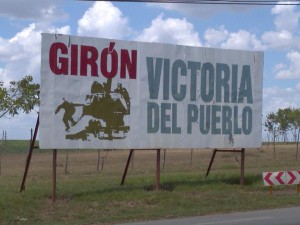Building a Revolutionary Consciousness
May 3, 2012 by admin
When the Revolutionary government took control of Cuba in 1959, an important part of their campaign to consolidate power was changing the way the population thought. This became especially important after 1961 when the Revolution was declared socialist, and the government made a concerted effort to move away from the pro-capitalist thought that was so prominent in the Batista era. This new consciousness that the government purported was based around severe nationalism and a common Cuban identity that stood in the face of the powers of “imperialists,” as Fidel Castro so often referred to capitalists and the United States. What’s so unique about Cuba is that the government has actually managed, to a large degree, to change the way the Cuban nation thinks in terms of person-to-person relationships and person-to-world relationships, and continues to do so to this day.
An important way of doing that, and it is blissfully obvious throughout every city and along every road, is the use of Revolutionary art. George Orwell once said, “All art is propaganda,” and this sentiment certainly holds true about much of the art along the walls in Havana or for the billboards out on the roads. “Revolutionary” art, however, is a contested idea, and has been for quite a while. This is because the government declared that artistic freedom would be allowed, so long as the artist did not create something that was “counterrevolutionary” in nature. Of course, this is not artistic freedom, but it does explain why much of the art is clearly projects sponsored by the government. Walls covered in the phrase “Socialismo o Muerte” or “Girón, Victoria del Pueblo” serve to reinforce the Revolutionary consciousness that the government seeks. The effect is twofold: the messages are directed at everybody, so they first make everyone feel a sense of togetherness and secondly, instead of the state taking responsibility for its accomplishments, such as the victory at the Bay of Pigs, it directs that victory towards the people, again building national unity. Further, they portray a romanticized vision of Cuba, on that stands in the face of opposition and stays strong regardless of the struggles.
Another important part of this art is the widespread use of the cult of personalities surrounding both Fidel Castro and Che Guevara. Both of their images and phrases they uttered are put all over Cuba, and the effect is the same building of national unity. Both of these men represent not themselves, but an idea of Cuba that the Revolutionary government is building towards. Their ideas are the essence of “Revolutionary” thinking, so it is appropriate that their messages and ideas are put up for others to see. Most Cubans see Revolutionary leaders, but most significantly these two men, as father figures to the country and to themselves.
By using this type of art, the Revolutionary government has indeed helped shape the national identity that they seek, and continue to do so. It is not necessarily brainwashing, but a reinforcement of their ideas and projection of those ideas to others. It seems as if this national consciousness is indeed there, as Cubans don’t view their government as oppressive or wrong, even during the economic crisis their country still faces.
Leave a Reply
You must be logged in to post a comment.


